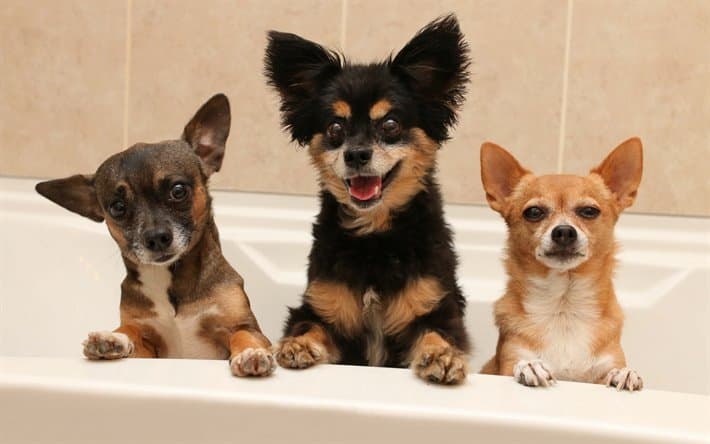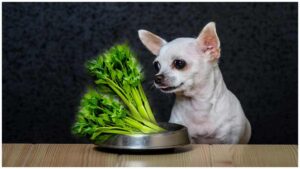Want to discover more about different Chihuahua types? Great!
There are 2 official Chihuahua types:
- Short-Hair Chihuahuas
- Long-Hair Chihuahuas
Below you’ll learn a little more about these standard Chihuahuas and how they differ from each other.
1. Short Hair Chihuahua
The first kind of Chihuahua that is commonly found in the Short-Hair Chihuahua.
This type of Chihuahua is also known as the Smooth Coat Chihuahua. The hair types for all Chihuahuas vary greatly and usually do not correlate with their hair length.
A Short-Hair Chihuahua can have either soft or rough hair. These dogs do not need any hard grooming for their coat, such as cutting or styling. They do have an undercoat, which, surprisingly, sheds more than longer-coated Chihuahua types.
Chihuahuas were bred as short-haired breed because they come from Mexico. Mexico is a tropical country known for its deserts, jungles, and hot weather.
That’s why most of the dog breeds from Mexico and Latin America were bred to have short hair or smooth coats. Due to having a short coat, Short-Hair Chihuahuas may get sunburned if left out in the summer sun, and they may get pests such as fleas and ticks.
Make sure that your Short Hair Chihuahua has lots of shade and water and that they get medicine to keep fleas and ticks away.
2. Long Hair Chihuahua
The other type of Chihuahua known in the breed standard is the Long Hair Chihuahua. This Chihuahua is like the Short Haired Chihuahua in weight, size, and body type.
In fact, if you shaved a Long Hair Chihuahua short, you’d have a dog that is just like the Short Hair Chihuahua!
Caution: Joke aside, do not ever have a Chihuahua shaved. Shaving the fur can result in fur and even skin damage.
Long-Hair Chihuahuas do need a bit of brushing to keep their long hair neat. These fluffy dogs are not nearly as high maintenance as Hollywood often makes them out to be. With a weekly brushing to prevent matting and some occasional hair trims, these little guys are good to go.
Hollywood has made these little dogs into stars. Chihuahuas’ publicity being seen in movies and TV shows has increased the love for Chihuahuas in the United States.
Chihuahuas are #24 out of 178 breeds in popularity based on American Kennel Club polls. That’s pretty popular!
Since their coat type is longer, Long Hair Chihuahuas do not need a second coat to stay warm. Their hair tends to be easy compared to some other long-haired breeds.
Long Hair Chihuahuas do not shed as much as other long-haired dog breeds.
Unofficial Chihuahua Types
There are only two kinds of Chihuahuas that are known by the breed standard and accepted in dog show rings across the world.
Several kinds of Chihuahuas are not known as official types of the breed.
They still stand out from other Chihuahuas in their unique features, though.
3. Apple Head Chihuahua
Apple Head Chihuahuas are called this because of the dome-like shape of their head— it’s shaped almost exactly like an apple!
Because of this shape, their eyes tend to protrude further than other kinds of Chihuahuas. They come with short noses and small bodies all the way around. They also tend to have shorter and ‘stubbier’ legs.
Caution: With their bulging eyes, Apple Head Chihuahuas can be prone to eye problems, such as eye scratches or ingrown eyelashes.
If you have an Apple Head Chihuahua, make sure to watch its eyes close for any sign of damage like squinting or pawing at the eyes. Another health problem with Apple Head Chihuahuas is that they often have a soft spot on their head. It’s called a molera.
If a Chihuahua is bitten in the head by a larger dog or has a head injury, this soft spot can cause brain bleeding or damage.
Apple Head Chihuahuas are also more prone to health problems with their teeth and sinuses than other types of Chihuahuas. If you have this type of Chihuahua, be sure to keep an eye on their health.
4. Deer Head Chihuahua
The Deer Head Chihuahua has a very narrow head, a longer nose, and longer legs than an Apple Head Chihuahua. Unlike the Apple Head Chihuahua, the Deer Head Chihuahua can’t compete in dog shows due to their head’s size and shape.
The round head shape is wanted in show rings. Deer Head Chihuahuas are referred to as “deer heads” because of their head shape, big dark eyes, and (usually) brown coloring.
With these looks, they look like young deer. Deer Head Chihuahuas also tend to have longer limbs than their apple-headed friends. This adds to the deer-like look.
The good thing about having a Deer Head Chihuahua, even though they can’t compete at the show, is that they have a more natural head shape.
Note: Deer Head Chihuahuas also tend to have fewer health problems than other types of Chihuahuas.
Besides that, many Deer Head Chihuahua owners report that this type of Chihuahua is more confident than some other Chihuahua types. These dogs are less likely to be afraid of large animals or people.
5. Teacup Chihuahua
The Teacup or Micro Chihuahua is the smallest Chihuahua of its kind, coming in at six inches tall and only three pounds.
At the same time, the average Chihuahua tends to be about four pounds but usually does not exceed six pounds.
Chihuahuas are the smallest breed of dog in the world, but they have the biggest brain-to-body size ratio among all breeds of dogs.
This means that they are pretty smart for their size!
They certainly make up for what they lack in size or height with their big personalities. Chihuahuas are vocal dogs that are very playful and have mid to high energy levels.
They love to be around you and go everywhere you go, but they are no strangers to a good afternoon siesta. A major drawback of Teacup Chihuahuas though, is that they tend to be priced higher than their larger Chihuahua counterparts.
The reason is that these super-small dogs are prized designer accessories. Many of the world’s top celebrities have been known to carry a teacup Chihuahua around in a bag.
There are other health problems in Teacup Chihuahuas. These tiny dogs tend to get bone breaks due to their fragile skeletons and can also be hard to toilet-train.
Note: If you decide to get a Teacup Chihuahua, be gentle with them! These little lovers need a lot of tender care.
6. Long-Hair Deer Head Chihuahua
The Long Hair Chihuahua is technically a standard breed type of the Chihuahua. It can also be found under the unofficial breed types because there are so many kinds.
One type of Long Hair Chihuahua that is not part of the standard breed type is the Long Hair Deer Head Chihuahua. These Chihuahuas can be found all over the world, along with Short Hair Chihuahuas.
As with many Chihuahuas, the fawn is the most popular color. Long Hair Chihuahuas are usually found in black and white-colored coats, too.
Long-Hair Chihuahuas that go outside need to be checked carefully when they come back in. These long-haired little guys are magnets for burrs, stickers, and other dirt caught in their coats.
With just a little brushing and some regular baths, the long silky hair on these Chihuahuas can be kept in tip-top shape.
7. Fawn Chihuahua
Their distinct color and coat type are the known traits of a Fawn Chihuahua. A Fawn Chihuahua is simply a Deer Head Chihuahua or an Apple Head Chihuahua or a Teacup Chihuahua with a fawn color.
This tan color is like the color of a newborn baby deer’s fur, and so this type of Chihuahua was named fawn.
It might seem a little odd that a Chihuahua described as a Fawn Chihuahua could also be the same as a Deer Head Chihuahua with different coat color.
They’ve been around a long time, so dog lovers had to get a bit creative in coming up with names for all the different types of Chihuahuas.
Chihuahuas come in the following combinations:
- Nine colors.
- Two coat types.
- Four different body types.
- Six different types of markings.
It’s no wonder people had to come up with unofficial categories to put some of them under. But that just means there are more Chihuahuas to love!
With that being said, let’s jump to the:
8. Pear Headed Chihuahua
The Pear Headed Chihuahua is the least common type of Chihuahua that you might see. The Pear Headed Chihuahua is kind of like a Deer Head Chihuahua.
The difference is that this Chihuahua features a head shape with a slightly flatter skull and a bigger snout than the Deer Head or Fawn Chihuahua. There isn’t a lot of difference between a Pear Headed Chihuahua and an Apple-Head Chihuahua when it comes to health and manners.
Pear Headed Chihuahuas aren’t good show dogs. They often have bad enough faults to keep them out of the show because of their head and nose shape.
Chihuahua mixes
There are official and unofficial types of Chihuahuas out there in the world. There are also several other kinds of dogs that Chihuahuas mix with. These crosses are performed to create fun, new mixes.
Note: Chihuahua crosses are often used to shrink a larger breed to a more manageable package.
No Chihuahua mixes can compete in breed dog shows. But these designer dogs are still very popular with the public and can sell for thousands of dollars. When choosing a puppy that is a Chihuahua mix, it’s a good idea to see if you can look at both of the parents.
This gives you an idea of what the resulting puppies may look like as adults and what their temperament might be like.
9. Chihuahua Jack Russell mix
Often called a Jack Chi, a Chihuahua Jack Russell mix is a cross between a Jack Russell Terrier and a Chihuahua. These cute little guys can grow anywhere between eight to eighteen pounds.
Along with being called JackChis, they’ve also found themselves with the nickname Jackahuahua. Chihuahuas that are mixed with Jack Russell usually end up keeping their small size.
They may be more excitable or hyperactive from their terrier blood. They also may be more prone to digging or chasing rodents than full-blooded Chihuahuas.
A Chihuahua Jack Russell Mix often keeps the Jack Russell breed’s color over the Chihuahua breed. This includes their snow-white color and darker mask markings on the face.
Some Chihuahua Jack Russell mixes do show more of their fawn Chihuahua coat color.
If a Short-Hair Chihuahua is mixed with a Jack Russell Terrier, the puppies will be short-haired dogs, for sure. Jack Russell Terriers also come in a wiry variety. This means that they can be bred with Chihuahuas to create a wire-haired Chihuahua mix too!
10. Chihuahua Yorkie Mix
Up next, we have a Yorkshire Terrier mixed with a Chihuahua to create the adorable Chorkie.
Chorkies come from two of the smallest breeds, so Chorkies tend to stay at eight to ten pounds. Even though they are little, these dogs have some medium to high energy packed inside their tiny bodies.
Chorkies are among the most popular of designer dog breeds. Both Chihuahuas and Yorkies remain small and have good personalities for small lap dogs.
The bad thing about the Chorkie mix is that these dogs sometimes can bark a lot, especially if they get bored or don’t have enough to do. Chorkies are such popular designer dogs that it is not uncommon to see Chorkie puppies sell for more than a thousand dollars.
A price between $400 and $800 is much more reasonable for one of these mixes. Anyone who has seen one of these fluffy little gems will understand why they sell for such a high price! Even though they tend to cost a lot of money, Chorkie puppies sometimes have a hypoallergenic coat like their Yorkie parent.
This makes them a good choice for dog owners who tend to have dog-related allergies.
11. Chihuahua Pitbull mix
This unusual mix comes from breeding a purebred Chihuahua and a purebred American Pitbull Terrier. Unfortunately, these dogs have no fun nicknames but come with lots of love and energy.
These dogs are perfect for an active family looking for a medium-sized dog coming in at around fifteen to twenty pounds fully grown.
Caution: Because an American Pit Bull is a much larger and stronger dog than a Chihuahua, male pit bulls mustn’t be mated with female Chihuahuas. This can result in the Chihuahua being bred with puppies that she is too small to deliver safely. The safer cross is to match a male Chihuahua to a female pit bull.
Both Chihuahuas and Pit Bulls can be nervous breeds. This crossbreed must receive lots of love and training to prevent them from becoming a nervous wreck.
Pit Bulls have a bad reputation for fighting other dogs. Sometimes Chihuahuas do, too. This bad behavior should be nipped in the bud at an early age with Chihuahua Pitbull Mix puppies.
Be careful if you get a Chihuahua Pitbull Mix. Many apartments and other housing units list Pit Bull mixes as prohibited breeds, no matter what the pit bull is mixed with. That means that the dog may be excluded from certain homes and apartments with banned breed lists.
12. Chihuahua Pug mix
A Chihuahua Pug mix comes in cute nicknames galore, including:
- Chug.
- Pugwawa.
- Pughuahua.
These little guys have short coats and weigh anywhere from ten to twenty pounds.
Chihuahua Pug mixes can be adorable! But a problem that can arise with these little guys is health issues because of their short noses and round heads.
Caution: Both Chihuahuas and Pugs are known for these health problems. Crossing the two breeds can sometimes make them worse.
The good news is that crossbreeding can prevent diseases that pose problems for purebred dogs. That means a Chihuahua Pug mix can sometimes be healthier than a purebred Chihuahua or Pug. It depends on each dog.
Chihuahua Pug mixes usually have playful, affectionate, and loyal Pug personalities. They also carry the strong and lively personality of the Chihuahua.
This can lead to a mixed dog with a fun-loving and friendly attitude.
13. Chihuahua Rat Terrier mix
Although the name might not give off the cutest impression, the Rat-Cha or Rat-Chi is a cute and very loyal friend. These dogs find their person in the house and prefer their company over anyone else’s.
Chihuahua Rat Terrier mixes often have a strong prey drive and will go after small animals like rabbits and rodents. That’s why if they are kept in households with other animals, you’d want to keep them separated.
Chihuahua Rat Terrier mixes can come in a wide variety of colors since both Chihuahuas and Rat Terriers come in many colors. This crossbreed tends to have large, high-set “radar” ears and a fine pointed nose. Chihuahua Rat Terrier mixes tend to be good guard dogs and bark to alert their owners to intruders.
As Rat Terriers, Chihuahua Rat Terrier mixes tend to be diggers and barkers. Rat Terriers and Chihuahuas are both small breeds, so a mix of these two will stay on the small side. Weighing in at around twelve to fifteen pounds, these guys are the perfect lap dog.
They will surely take advantage of that when their person is around!
Bonus: Chihuahua Husky mix
This guy is a mix of a Siberian Husky and a Chihuahua, and he is not common due to having to be bred artificially.
Caution: Because of the big size difference between a Husky and a Chihuahua, they can’t mate naturally to create this adorable little mix.
Often called Chi-Husky or Husky-Chi, this larger mix can often weigh between forty-five and sixty pounds. Huskies are usually large dogs, and this can be a major problem with the breed. But Miniature Huskies are often made by mixing Huskies with smaller breeds such as Chihuahuas.
Chihuahua Husky mixes often take on their Husky parent’s wolf-like markings and keep the smaller size of their Chihuahua parent. Many of these mixes don’t look like a small Husky, but instead a straight mix of the two breeds. This means you might end up with a mix that does not look much like either breed.
Another unique feature of this mix is that it allows for Chihuahuas with blue or light-colored eyes. These blue eyes are common in Siberian and Alaskan Huskies but are rare in Chihuahuas. Even though it could be a nice bonus for you, this is considered a flaw in the show.
Which is better – A purebred Chihuahua or a mix?
There are good things about both purebred Chihuahuas and Chihuahua mixes.
Purebred Chihuahuas are a good option for people who want to know exactly what their Chihuahua puppy is going to look like when they grow up.
They are also a good choice for people who want a good idea of what their puppy’s attitude will be like. In contrast, mixes have much more variation in the breeding results with regard to color, head shape, size, and markings.
That means, with a mix, you don’t really know what you’re getting until the puppy grows up. This applies to the puppy’s temperament, as well as their looks.
There are advantages to choosing a Chihuahua mix, too, though. A study on purebred and mixed dogs has found that Crossbreed and mixed breed dogs are less prone to genetic disorders than purebred ones.
If you want to join in dog shows, you’ll want to go with a purebred Chihuahua (either a Short Hair or Long Hair Chihuahua).
You’ll also need to choose your puppy with care if you want a show dog. You’ll want to choose a puppy that is as close to the Chihuahua breed standard as you can to have the best chance of winning at the show.
How do I choose a Chihuahua type?
So you’re trying to decide what kind of Chihuahua type is right for you, but there are so many you’re having a hard choice deciding.
It’s easy to understand—there are so many cute Chihuahuas to choose from!
Here are some things to think about when choosing a type of Chihuahua:
Do I have allergies?
If you have dog allergies, Long-Hair Chihuahuas are a better choice than Short-Hair Chihuahuas since they tend to shed less.
You might also want to look into getting a Chihuahua Yorkie mix since they are considered hypoallergenic.
For other Chihuahua types, allergy symptoms can be reduced by regular washing, grooming, and filtration in the home.
Do I want a long-haired or a short-haired dog?
Long-haired dogs need more grooming and coats that can tangle without being brushed. Short-haired dogs tend to shed more and may get more fleas and ticks.
Do I want a purebred dog or a mix?
There are always pros and cons to having purebred Chihuahuas and Chihuahua mixes.
Which is a better choice for you depends on what you want from your future dog.
That’s why it’s a good idea to inform yourself about each breed or mix. And then, simply check whether the pros outweigh the cons for you and vice versa.
How do I want my Chihuahua to look?
Apple-Head Chihuahuas, Deer Head Chihuahuas, and Pear Head Chihuahuas all have unique looks to their face and head. Compare pictures of the different Chihuahua types to see which type you like most.
How big do I want my dog to be?
If you get a purebred Chihuahua, you can depend on your dog being small. On the contrary, a Chihuahua mixed with another breed may grow larger than you originally expected.
How much money do I have to spend on a dog?
Some designer Chihuahua mixes cost several hundred dollars.
Purebred Chihuahua puppies without registration papers can be sold for much less since this breed is very popular and common. You should think about your options carefully before choosing a type of Chihuahua to add to your home. It is not a decision to consider lightly!
A Chihuahua lives for a long time, so if you take care of them well, you will have them as part of your family for many years.
Remember: All Chihuahua types are great
No matter what type of Chihuahua you have or end up getting, there are good things to be said about all these wonderful dogs.
The Chihuahua is such a great dog wrapped up in a small package that you can’t help but fall in love with it!




